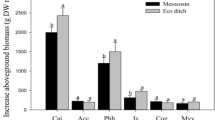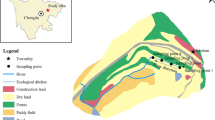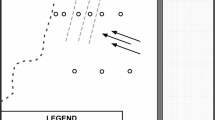Abstract
The influence of inundation depth on phytomass, shoot density, photosynthesis, elongation, and nutrients of Typha domingensis in Stormwater Treatment Area-1East (STA-1East) was examined and results were evaluated relative to phosphorus (P) treatment from 2006 to 2011. Biomass and nutrient concentrations of T. domingensis were not related to inundation depth. Necromass and belowground/leaf biomass ratio increased with increasing inundation depth from 30 to 80 cm. Shoot density, photosynthesis, and elongation decreased with inundation depth. The contents of necromass nutrients and phytomass nitrogen increased with inundation depth. Annual total P (TP) concentration increase (−) or decrease (+) from inflow to outflow was −21 %, −3 %, +8 %, −54 %, +41 %, and +29 % in 2006–2011, respectively. Decreases in soluble reactive P (SRP), total dissolved P (TDP), dissolved organic P (DOP), and/or particulate P (PP) from inflow to outflow were low or did not occur annually. Prolonged inundation damaged T. domingensis community and thus adversely impacted the capacity of the system to treat P. Inundation depths in the STAs can be categorized into optimal, subtle stress, and lethal stress zones. This study stressed the importance in maintaining vegetation within an optimal zone of inundation for a sustainable system.









Similar content being viewed by others
References
Aldous A, McCormick P, Ferguson C, Graham S, Craft C (2005) Hydrologic regime controls soil phosphorus fluxes in restoration and undisturbed wetlands. Restoration Ecology 13:341–47
American Public Health Association (1998) Standard methods for the examination of water and wastewater, 20th edn. American Water Works Association and Water and Environment Federation, Washington, DC
Boers AM, Zedler JB (2008) Stabilized water levels and Typha invasiveness. Wetlands 28:676–685
Chabbi A, McKee KL, Mendelssohn IA (2000) Fate of oxygen losses from Typha domingensis (Typhaceae) and Cladium jamaicense (Cyperaceae) and consequences for root metabolism. American Journal of Botany 87:1081–1090
Chen H (2011) Surface-flow constructed treatment wetlands for pollutant removal: applications and perspectives. Wetlands 31:805–814
Chen H, Zamorano MF, Ivanoff D (2010) Effect of flooding depth on growth, biomass, photosynthesis, and chlorophyll fluorescence of Typha domingensis. Wetlands 30:957–965
Chen H, Zamorano MF, Ivanoff D (2013) Effects of deep flooding on nutrients and non-structural carbohydrates of mature Typha domingensis and its post-flooding recovery. Ecological Engineering 53:267–274
Chimney MJ, Newman J (2006) Everglades nutrient removal project test cell research: optimizing Stormwater Treatment Area performance—the importance of hydrologic conditions in maximizing nutrient retention by the STAs. Technical Publication ERA #438. South Florida Water Management District, West Palm Beach
Chimney MJ, Nungesser M, Newman J, Pietro K, Germain G, Lynch T, Goforth G, Moustafa MZ (2000) Chapter 6 Stormwater Treatment Areas. 2000 Everglades consolidation report. South Florida Water Management District, West Palm Beach
Craft CB, Richardson CJ (1993) Peat accretion and phosphorus accumulation along an eutrophication gradient in the northern Everglades. Biogeochemistry 22:133–156
D’Angelo EM, Reddy KR (1999) Regulators of heterotrophic microbial potentials in wetland soils. Soil Biology and Biochemistry 31:815–830
Davis SM (1982) Patterns of radiophosphorus accumulation in the Everglades after its introduction into surface water. Tech. Pub. 82-2. South Florida Water Management District, West Palm Beach
DeBusk WF, Reddy KR (2005) Litter decomposition and nutrient dynamics in a phosphorus enriched Everglades marsh. Biogeochemistry 75:217–240
DeLaune RD, Jugsujinda A, Reddy KR (1999) Effect of root oxygen stress on phosphorus uptake by cattail. Journal of Plant Nutrition 22:459–466
Fraga JMP, Kvet J (1993) Production dynamics of Typha domingensis (Pers.) Kunth populations in Cuba. Journal of Aquatic Plant Management 31:240–243
Germain G, Pietro K (2010) Chapter 5 performance and optimization of the Everglades Stormwater Treatment Areas. In 2011 South Florida Environmental Report, West Palm Beach, FL, USA
Grace JB (1989) Effect of water depth on Typha latifolia and Typha domingensis. American Journal of Botany 76:762–768
Ivanoff D, Chen H, Gerry L (2012) Chapter 5 performance and optimization of the Everglades Stormwater Treatment Areas. In 2012 South Florida Environmental Report, West Palm Beach, FL, USA
Kadlec RH, Knight RL (1996) Treatment wetlands. CRC Press, Boca Raton
Kadlec RH, Wallace SD (2009) Treatment wetlands, 2nd edn. CRC Press, Boca Raton
Knight RL, Gu B, Clarke RA, Newman JM (2003) Long-term phosphorus removal in Florida aquatic systems dominated by submerged aquatic vegetation. Ecological Engineering 20:45–63
Lamers LPM, Tomassen MHBM, Roelofs JGM (1998) Sulfate-induced eutrophication and phytotoxicity in freshwater wetlands. Environmental Science and Technology 32:199–205
Miao SL, Zou CB (2012) Effects of inundation on growth and nutrient allocation of six major macrophytes in the Florida Everglades. Ecological Engineering 42:10–18
Pietro K, Germain G, Bearzotti R, Iricanin N (2011) Chapter 5 performance and optimization of the Everglades Stormwater Treatment Areas. In: 2011 South Florida Environmental Report, South Florida Water Management District, West Palm Beach, FL, USA
Qualls RG, Richardson CJ (1995) Forms of soil phosphorus along a nutrient enrichment gradient in the northern Everglades. Soil Science 160:183–198
Qualls RG, Richardson CJ (2000) Phosphorus enrichment affects litter decomposition, immobilization, and soil microbial phosphorus in wetland mesocosms. Soil Science Society of America Journal 64:799–808
Reddy KR, DeLaune RD (2008) Biogeochemistry of wetlands. CRC Press, Taylor and Francis Group, Boca Raton
Reddy KR, Kadlec RH, Flaig E, Gale PM (1999) Phosphorus retention in streams and wetlands: a review. Critical Reviews in Environmental Science and Technology 29:83–146
Richardson CJ (2008) Long-term phosphorus assimilative capacity (PAC) in the Everglades. In: Richardson CJ (ed) The Everglades experiments. Springer, NY, pp 567–578
Sklar FH, Chimney MJ, Newman S, McCormick P, Gawlik D, Miao S, McVoy C, Said W, Newman J, Coronado C, Cozier G, Korvela M, Rutchey K (2005) The ecological-societal underpinnings of the Everglades restoration. Frontiers in Ecology and the Environment 3:161–169
Sorrell BK, Hawes I (2010) Convective gas flow development and the maximum depths achieved by helophyte vegetation in lakes. Annals of Botany 105:165–174
South Florida Water Management District (SFWMD) (2007) STA-1East operation plan. West Palm Beach, FL, USA
Tate RL III (1980) Microbial oxidation of histosols. Advances in Microbial Ecology 4:169–210
Vymazal J (2007) Removal of nutrients in various types of constructed wetlands. Science of the Total Environment 380:48–65
Wetland Solutions, Inc (2004) Constraints on hydraulic loading rates to Stormwater Treatment Areas. Gainesville, FL, USA
Wetzel RG (2001) Fundamental processes within natural and constructed wetland ecosystems: short-term versus long-term objectives. Water Science and Technology 44:1–8
Acknowledgments
We thank M. Zamorano and M. Korvela for assistance in the field and S. Gray, D. Ivanoff, T. Piccone, L. Schwartz, and D. Unsell for comments on an early version of this manuscript.
Author information
Authors and Affiliations
Corresponding author
Rights and permissions
About this article
Cite this article
Chen, H., Vaughan, K. Influence of Inundation Depth on Typha domingensis and its Implication for Phosphorus Removal in the Everglades Stormwater Treatment Area. Wetlands 34, 325–334 (2014). https://doi.org/10.1007/s13157-013-0500-3
Received:
Accepted:
Published:
Issue Date:
DOI: https://doi.org/10.1007/s13157-013-0500-3




